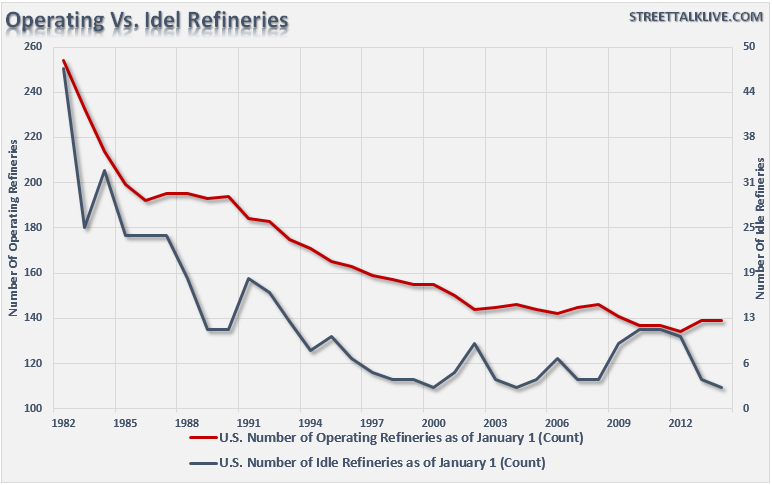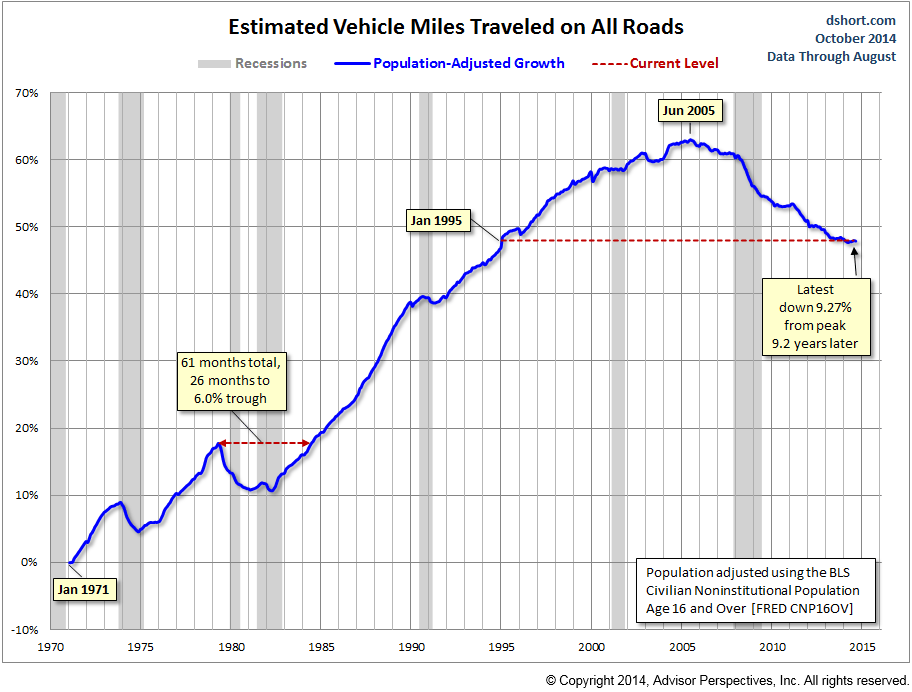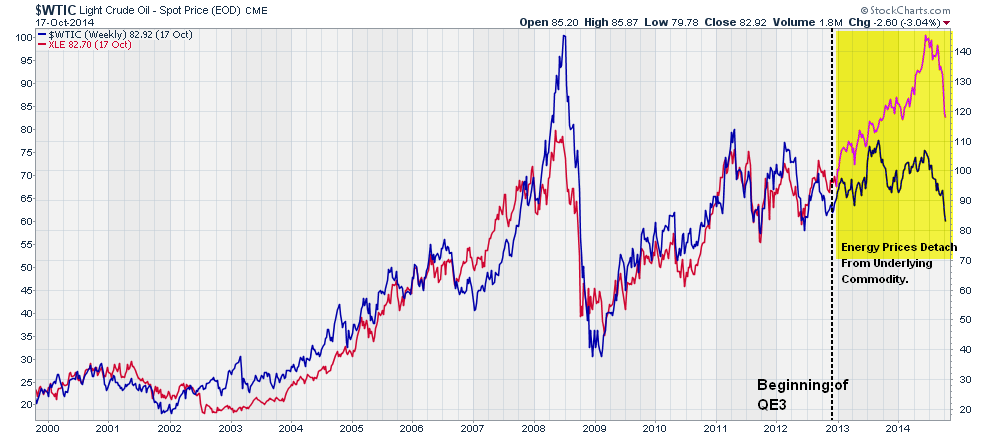Last week, I touched on the issue of oil prices and demand stating:
"First, the development of the “shale oil” production over the last five years has caused oil inventories to surge at a time when demand for petroleum products is on the decline as shown below."
"The obvious ramification of this is a “supply glut” which leads to a collapse in oil prices. The collapse in prices leads to production “shut ins,” loss of revenue, employee reductions, and many other negative economic consequences for a city dependent on the production of oil.
Secondly, I have also discussed that the “fracking miracle” may not be all that it is believed to be due to fast production decline rates and massive amounts of leverage. Just recently Yves Smith posted an article discussing this very issue stating:"
“The oil and gas sector is capital intensive. Drillers have borrowed phenomenal amounts of money, which was nearly free and grew on trees, to acquire leases and drill wells and install processing equipment and infrastructure. Even as debt was piling up, the terrific decline rates of fracked wells forced drillers to drill new wells just keep up with dropping production from old wells, and drill even more wells to show some kind of growth. One heck of a treadmill. Funded in part by junk debt.
Junk bond issuance has been soaring as the Fed repressed interest rates and caused yield-hungry investors to close their eyes and take on risks, any risks, just to get a teeny-weeny bit of extra yield. Demand for junk debt soared and pushed down yields further. And even within this rip-roaring market for junk bonds, according to Bloomberg, the proportion issued by oil and gas companies jumped from 9.7% at the end of 2007 to 15% now, an all-time record.”
I received many emails on those comments that deserved a response and/or further clarification.
As with all things, the question of oil prices is nothing more than a supply/demand issue. As shown above, the sharp increase in production brought on by "fracking" has certainly been quite remarkable. However, this remarkable resurgence in oil production currently faces two extremely strong headwinds. The total amount of available refining capacity and the level of end demand are both declining.
While the "fracking miracle" has boosted the production of raw crude in recent years, such production is only useful if you can convert the base commodity into a useful byproduct. The problem, as shown in the two charts below, is that the the number of operating refineries has continued to fall, as the regulatory environment has stifled the ability to build new plants, and operating plants are already running near full capacity.
With very little spare capacity available domestically, the "hope" is that the U.S. can start exporting the excess to foreign countries. However, as discussed in the first chart above, global demand for oil is dropping as the Eurozone and Japan struggle with extremely weak economic growth. Furthermore, since oil is priced in U.S. dollars, the surging U.S. dollar as of late only makes oil more expensive to foreign customers while will likely crimp demand further.
There is more at issue with the "demand" side of the equation than just refinery capacity and short-term economic variables. The longer term demand shift is a function of technology continuing to create efficiencies within the global economy along with decreases in vehicle fuel consumption.
For example, my friend Doug Short just recently posted the following discussing the number of vehicle miles driven, to wit:
"There are profound behavioral issues apart from gasoline prices that are influencing miles traveled. These would include the demographics of an aging population in which older people drive less, continuing high unemployment, the ever-growing ability to work remote in the era of the Internet and the use of ever-growing communication technologies as a partial substitute for face-to-face interaction."
The problem with dropping demand, of course, is the potential for the creation of a "supply glut" that leads to rapidly falling prices. When prices fall rapidly more production is "shut-in" and the pendulum swings from over to under production. This is the nature of all cycles and with those cycles come "booms and busts."
However, there are a couple of other points to make about the "fracking miracle" that will likely exacerbate the "supply/demand" imbalance noted above.
"Even in their best-case scenario—of a high and climbing oil prices—America’s shale producers will be pushed to maintain the high level of output they have achieved in recent years. This is because a shale well has a limited lifespan of around seven or eight years. Its output plummets after the first three years, then deteriorates steadily thereafter. By contrast, a conventional oil field produces crude at a level that wanes slowly over the course of decades. Saudi’s massive Ghawar field, for example, began production in 1951 and is still pumping out around 5 million barrels a day.
The IEA points out that the U.S. shale industry will need to bring 2,500 wells into service every year to sustain the output—of 1 million barrels a day—of one of its main oil reserves, in North Dakota.
Some of these wells may require more investment than their predecessors,“a rising percentage of supplies…require a higher breakeven price,” as the IEA put it.
Observers like Berman and Hughes believe the U.S. needs to prepare for a time when the shale tide starts to ebb. Perhaps hundreds of thousands of jobs would be lost and the U.S. economy would again be highly vulnerable to oil price spikes and dependent on Middle Eastern exporters who can guarantee long-term, plentiful supplies."
Jim Quinn detailed the problem with the sharp decline rates a bit further.
- To maintain production of 1 million barrels of oil a day from Iraq one needs to drill just 60 new wells a year. Extracting the same amount from the Bakken would require 2,500 new wells.
- A typical fracked well poked in the ground in Oklahoma in 2009 debuted with an output of about 1,200 barrels of oil per day. Just four years later, however, output from the same well has fallen to just 100 barrels of oil per day.
- To double that output from the Bakken, for instance, would require 5,200 new wells a year, and tripling it would require 7,800 and so on. Then, to the horror of all, less than a decade after all that was done, that additional million barrels of oil a day in production would be reduced to just 100,000, no matter what the oil companies do, because of the nature of the formation where the well was drilled.
- California’s Monterey Shale, which the U.S. Energy Information Agency thought contained 13.7 billion barrels of oil in 2011, came up a little light in the loafers. Closer examination revealed the formation to be much more broken up underground than previously thought — so much so that only around 600 million barrels may ultimately be recovered with current technology. That’s a 97 percent downgrade, and there is no guarantee that other rosy predictions of shale oil riches both in the U.S. and elsewhere won’t have similar outcomes.
With oil prices and demand falling at a time when production is strongly rising, the risk of a supply/demand imbalance has significantly increased. This puts the prices and valuations of energy companies, particularly drillers and service suppliers, at risk as well. As shown in the chart below, the advent of QE3 has pushed the prices of energy stocks well outside of their long-term correlation with oil prices. The risk is clearly prevalent.
The problem for a city like Houston, which deep ties to the production and oil, is a "shock" from a supply/demand reversion could bring the economic "boom" quickly to an end.
I am certainly not saying that the "wheels are about to come off of the cart." However, I do suggest that there is a potential for a very negative shock in the energy space given the extreme complacency that current exists. History suggests that true "miracles" are few and far between as most tend to just be "illusions of hope."





